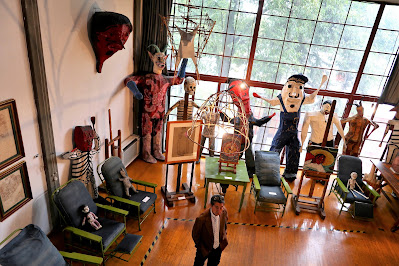Diego Rivera, the famous Mexican muralist, was also an obsessive collector of pre-Hispanic artifacts during his life, and by the time of his death he had amassed over 50,000 ancient objects. Rivera often sought artistic inspiration for his murals from these pieces, and indeed his greatest artwork often portrays scenes from pre-Hispanic history that reveal the reverence and curiosity he felt toward the past.
For decades, Rivera and his wife, Frida Kahlo, had planned to build a museum where the Mexican public could visit and contemplate their collection. Rivera saw some sketches by architect Juan O’Gorman and
after consulting with the famous American architect Frank Lloyd Wright,
he designed this building himself. The Anahuacalli construction began in 1942. Unfortunately, due to other commitments and ill health, Rivera’s dream never came to full fruition during his lifetime. When he died in 1957, his daughter Ruth collaborated with Juan O’Gorman and Dolores Olmedo (along with her generous sponsorship) in order to fulfill the artist’s wishes and complete the project by 1963.
The museum building itself was designed according to Mesoamerican principles of architecture and is meant to symbolize a pyramid with a total of twenty-three rooms distributed over three levels.
Several elements of the exterior are built in the Teotihuacan style,
while aspects of the interior were inspired by Maya temples and in reference to the Aztec pyramids, using a black volcanic stone common to the valley of Mexico.
You will also see many mosaics on the ceilings and walls, based on Rivera’s original designs, that depict the gods and goddesses of the pre-Hispanic cosmos.
A cast mosaic technique was implemented. Place some cardboard with the drawn sketches directly on a
wooden frame. On these boards, a glue was applied, then the pieces
of stone were adhered and finished the mortar. When dry, the form work and the cardboard were removed.
In the large central space located on the second floor of the
Anahuacalli, called the "Study", 16 sketches for different
murals made by Rivera in the early thirties are exhibited.
Among the sketches stands out the one made for the mural, Man at the Crossroads. Diego was commissioned to paint a large mural in the lobby of the Rockefeller Center in New York City. Thru his painting, he expressed views on the evils of capitalism and the positive aspects of socialism. As work progressed, he added a portrait of Lenin and other communist ideologies, figures not presented in his preparatory drawings. When he refused to change the mural, he was paid off and released from his obligation. In 1934, it was completely destroyed but in that same year, he received a commission to paint the exact mural at the Museo del Palacio de Bellas Atres in Mexico City.
While the designs of the ground floor ceiling mosaics are monochromatic, the mosaics on the upper sections were made with stones of different colors.
The upper terrace has a breathtaking view. Not to mention the exquisite stonework.The total area of land is almost 15 acres, in which Rivera dreamt of a "City of Arts", a space for artistic creation where architecture, painting, dance, music, sculpture, theater, crafts and ecology co-exist. In the center of the complex is a large central plaza, where various artistic and social events occur.
Located to one side of the main building is the Diego Rivera gallery, a space for high-quality temporary exhibitions. Another striking building is the Sapo-Rana Art Library, which houses various art books and the collection of 2,400 copies from the personal library of the anthropologist Eulalia Guzman, who donated them to the museum in the 1950's.Separate buildings laid out in this complex are connected by walkways. I could totally envision building something like this for individual housing.The spaces were just so intimate, inviting and at the same time instilled a sense of spaciousness. Such creative design!
In memory of Rivera, the following quote was chosen for the inscription engraved on the museum foundation stone: "I return to the people what I was able to rescue from the artistic heritage of their ancestors".
ANAHUACALLI ~ MUSEO DIEGO RIVERA
Calle Museo 150, San Pablo Tepetlapa
Coyoacán, Ciudad de México
Monday through Sunday
11 am - 6 pm



































